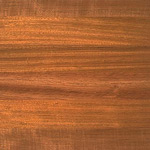Serving Upstate NY—VT—MA • For selections & prices, CALL or EMAIL US
Jatoba (Brazilian Cherry)
Wood Flooring Species
Scientific Name:
Hymenaea courbaril
Other Names and Species:
Algarrobo
Brazilian Cherry
Cuapinol
Guapinol
Jatahy
Kawanari
Paquio
Rode Locus
West Indian Locust
Origin:
From southern Mexico, throughout Central America and the West Indies, to northern Brazil, Bolivia, and Peru.
Appearance:
While the sapwood of jatoba is gray-white, the heartwood tends to a salmon-red to orange-brown color when fresh, becoming russet or reddish brown with dark streaks when seasoned. With its inherent beauty, rich coloring, and extreme hardness, this species is understandably one of our most popular exotic woods.
Properties:
In addition to its warm reddish tint, this moderately lustrous wood is notable for its hardness and durability — jatoba is an extremely dense wood and very strong.
Janka Hardness: 2350
Jatoba is one of the hardest choices for wood flooring. It is roughly eighty-one percent harder than red oak, seventy-eight percent harder than ash, about sixty-two percent harder than hard maple, close to twenty-three percent harder than jarrah, and is just over six percent harder than santos mahogany’s ranking of 2200.
Workability:
In view of its high density and interlocked grain, jatoba is difficult to saw and plane; however, it sands nicely to a smooth surface. Due to its hardness, nailing may require pre-drilling and adjustment of the angle of penetration.
Principal Uses:
Jatoba is frequently used where good shock resistance is needed, such as in wood flooring and tool handles. Other applications include railroad crossties, wheel rims, gear cogs, and other specialty items, as well as furniture and cabinet work.
Learn more about available grades of
Jatoba hardwood flooring »





